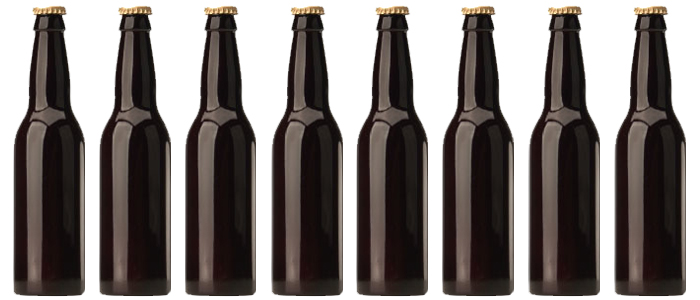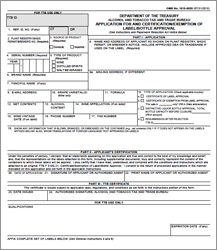Federal Beer Labeling Requirements

Published December 20th, 2020 by Foxhaus Creative
Written by Micah Kearns
"No person engaged in business as a brewer, wholesaler, or importer of malt beverages, directly or indirectly, or through an affiliate, shall sell or ship, or deliver for sale or shipment, or otherwise introduce in interstate or foreign commerce, or receive therein, or remove from Customs custody any malt beverages in containers unless the malt beverages are packaged, and the packages are marked, branded, and labeled in conformity with this subpart."
I don't know about you, but they sound serious.
So according to the TTB, any brewery selling beer in bottles needs to have labels with all of the federally mandated information displayed on it somewhere. Seems reasonable.
 Another important note is that the bottle itself cannot have any distinguishable marks from any company other than yours. This means that if you are reusing beer bottles, they have to be blank bottles without another brewery's name or emblems embossed on it, such as New Belgium's bottles with the distinctive raised ring around the neck, shown here. Even a more subtle non-text marking on the glass is prohibited from being used if it represents any other company but yours.
There's a lot of information available on the TTB's website, but here's an easier to read, easier to understand list of labeling requirements for your new brewery's bottled beer.
For a 12 oz. bottle, all information must be printed legibly, at least 2 millimeters tall, on a contrasting background, in English. Easy enough, right?
Another important note is that the bottle itself cannot have any distinguishable marks from any company other than yours. This means that if you are reusing beer bottles, they have to be blank bottles without another brewery's name or emblems embossed on it, such as New Belgium's bottles with the distinctive raised ring around the neck, shown here. Even a more subtle non-text marking on the glass is prohibited from being used if it represents any other company but yours.
There's a lot of information available on the TTB's website, but here's an easier to read, easier to understand list of labeling requirements for your new brewery's bottled beer.
For a 12 oz. bottle, all information must be printed legibly, at least 2 millimeters tall, on a contrasting background, in English. Easy enough, right?
On the main/front label, you must have:
1.) Brand Name Well, duh. If you're going to sell you beer, or any product really, it would probably help to include your brand/brewery name. I hope you have an awesome logo to go with it. 2.) Class This means the type of beer you're brewing. Ale, Porter, Stout, Lager, etc. If you're making exceptionally weak beer, you get some additional rules:"Products containing less than one-half of 1 percent (.5%) of alcohol by volume shall bear the class designation “malt beverage,” or “cereal beverage,” or “near beer.” If the designation “near beer” is used, both words must appear in the same size and style of type, in the same color of ink, and on the same background. No product containing less than one-half of 1 percent of alcohol by volume shall bear the class designations “beer”, “lager beer”, “lager”, “ale”, “porter”, or “stout”, or any other class or type designation commonly applied to malt beverages containing one-half of 1 percent or more of alcohol by volume."
3.) Name and Address of Brewery You need to include the name of your brewery (if it's different from your brand name, for example Anheuser-Busch owns many different breweries) and address.
4.) Net Contents As in, how many ounces of beer do you have in the bottle? Don't forget to specify Fluid Ounces, or Fl. Oz. If this is moulded into the bottle itself, it doesn't need to be included on the label.
5.) Alcohol Content How strong is your hootch? Use the percentage of Alcohol By Volume, or ABV. The term “non-alcoholic” can be used if the statement “contains less than 0.5 percent (or .5%) alcohol by volume” appears next to it, in readily legible printing and on a contrasting background. The term “alcohol-free” can only be used if it contains no alcohol.
On the main label or on a separate side or back label:
6.) Importer If your beer is imported, the name and address of the importing company must be included. 7.) Bottler/Packer If your beer is bottled or packed for you, the name and address of the bottler or packer must be included. 8.) Alcohol Content Must be included again on a back sticker, if mandated by state law. 9.) Government Warning Your label must display this in capital letters and bold type, at least 2mm tall, on a highly contrasting background:GOVERNMENT WARNING:
(1) According to the Surgeon General, women should not drink alcoholic beverages during pregnancy because of the risk of birth defects. (2) Consumption of alcoholic beverages impairs your ability to drive a car or operate machinery, and may cause health problems.
10.) FD&C Yellow No. 5 A statement that the product contains FD&C Yellow No. 5, if it in fact does. Maybe you want your beer to have that Day Glo look? Hopefully not.
11.) Aspartame If your beer is sweetened artificially with aspartame, “PHENYLKETONURICS: CONTAINS PHENYLALANINE.” must be on the label, in capital letters, separate and apart from all other information, in accordance with FDA regulations.
(1) According to the Surgeon General, women should not drink alcoholic beverages during pregnancy because of the risk of birth defects. (2) Consumption of alcoholic beverages impairs your ability to drive a car or operate machinery, and may cause health problems.
On the main, side, back, or neck label:
11.) Cochineal Extract and Carmine If your beer contains the color additive cochineal extract or carmine ( a.k.a. crushed beetle juice) you must include “Contains Cochineal Extract” or “Contains Carmine” on the label. 12.) Sulfites Sulfites is occasionally used to inhibit the growth of yeast in alcoholic beverages with residual sugars in them. If your beer contains sulfites in excess of 10ppm, the label must have “Contains sulfites” on it.Voluntary Additions to Labeling
13.) Allergy Information You can also voluntarily disclose any allergens you have included in your brew, such as tree nuts, milk, peanuts, grains, etc. I'll let them explain it:"Major food allergens used in the production of a malt beverage product may, on a voluntary basis, be declared on any label affixed to the container. However, if any one major food allergen is voluntarily declared, all major food allergens used in production of the malt beverage product, including major food allergens used as fining or processing agents, must be declared, except when covered by a petition for exemption approved by the appropriate TTB officer under §7.22b. The major food allergens declaration must consist of the word “Contains” followed by a colon and the name of the food source from which each major food allergen is derived (for example, “Contains: egg”)."
14.) Organic Any use of the term “organic” on a malt beverage label or in advertising of malt beverages must comply with the United States Department of Agriculture's (USDA) National Organic Program rules (7 CFR part 205) as interpreted by the USDA.
 Of course once you fit all of this information on your beer label, along with any other images and graphics, it needs to be attached to this COLA Application form and sent to the TTB for approval. You can send it online or to their center in Cincinnati, and then wait up to 90 days to hear what the verdict is.
If your label design passes muster, you're issued a certificate of label approval. Then you send the design to a label printer, slap it on bottles of your delicious beer, and you're off to the races! Next you can design 6-pack holders, cases, coasters, merchandise, neon signs, posters...
If it doesn't pass, you can either edit and resubmit your label or file an appeal arguing for approval.
Well I hope all of this information helps brewers that are looking to put their beer to market, and if you ever have questions or need help with the design process, please contact Foxhaus Creative! And feel free to share one of your beers too.
Of course once you fit all of this information on your beer label, along with any other images and graphics, it needs to be attached to this COLA Application form and sent to the TTB for approval. You can send it online or to their center in Cincinnati, and then wait up to 90 days to hear what the verdict is.
If your label design passes muster, you're issued a certificate of label approval. Then you send the design to a label printer, slap it on bottles of your delicious beer, and you're off to the races! Next you can design 6-pack holders, cases, coasters, merchandise, neon signs, posters...
If it doesn't pass, you can either edit and resubmit your label or file an appeal arguing for approval.
Well I hope all of this information helps brewers that are looking to put their beer to market, and if you ever have questions or need help with the design process, please contact Foxhaus Creative! And feel free to share one of your beers too.
Here's some additional links and resources from the TTB for new breweries:
TTB Guide to Starting A BusinessTTB Guide to Requirements For Brewery Operations
Federal Regulations - Labeling Proceeding
Federal Regulations - Labeling and Advertising of Malt Beverages
